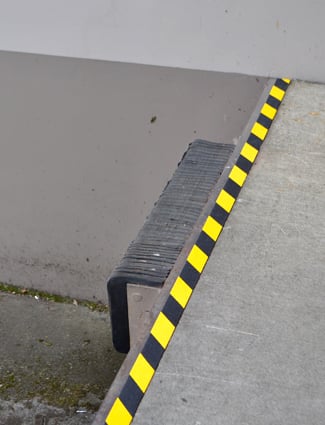Easy Ways to Enhance Loading Dock Safety
03
February,
2023
2 MINUTE READ

Situational awareness is important in any job, especially when dangers can blindside. In busy warehouses, a good proportion of injuries happen on loading docks. There is a lot of hustle and bustle in a warehouse, where workers can get sensory overload from the sights, sounds, and movement. Loading dock workers must move at a rapid pace to keep up with production, which adds to the danger. Accidents and injuries affect a company's bottom line by incurring OSHA fines, insurance claims, and interrupting production. Workplaces can use simple tips to improve loading dock communication, safety, and efficiency.
Load Up on Safety
There are more than 4.2 million material movers in the U.S., with most working in transportation and warehousing. Warehouse loading dock hazards include musculoskeletal, slips, trips, and falls, and caught or struck by accidents.
In 2018, a worker died from being struck by equipment in a loading dock area. According to the Occupational Safety and Health Administration, maintenance did not follow standards or safety best practices, including lockout/tagout, electrical, and arc flash safety, among others.
"Employers are required to train workers on safety practices, and use appropriate hazard controls to ensure their safety," said OSHA official Jeff Funke. "Proper safety controls and training can prevent fatalities like this from occurring."
 According to OSHA, material handling workplaces can avoid 70% of all accidents, including in loading dock areas, by using better precautions. Modern technology is assisting warehouse and dock safety through hazard-recognition, locking dock control, and warning systems. Yet, these new systems can only do so much. When safety tools work together, workplaces lower the risk of potential injury. Here are a few ways to reinforce dock safety:
According to OSHA, material handling workplaces can avoid 70% of all accidents, including in loading dock areas, by using better precautions. Modern technology is assisting warehouse and dock safety through hazard-recognition, locking dock control, and warning systems. Yet, these new systems can only do so much. When safety tools work together, workplaces lower the risk of potential injury. Here are a few ways to reinforce dock safety:
- Equipment: Workers need to be careful and pay attention to what is around them. Forklifts and machinery work quickly in warehouse environments. Alert workers to stop, go, and caution in specific areas, such as slotting and intersections. Chock trailer wheels and brace equipment during servicing or maintenance to prevent struck-bys. Make sure there is ventilation in areas that have chemicals, including equipment that runs on propane or gas.
- Prevent slips, trips, and falls: Prepare dock areas for extreme weather. Keep lighting adequate and loading areas clean. Do not obstruct loading docks or block electrical disconnects. Identify walking areas, mark dock edges, and draw attention to bollard posts. Report flooring cracks and other potential surface hazards. Store and organize PPE such as sturdy, nonskid shoes, gloves, back braces, hard hats, eye protection, and hearing protection. Block the dock drop-off area when not in use. Do not block pathways, emergency exits, or equipment. Secure loose items and pad sharp corners. Promptly clean up spills.
Improve Communication
Communication about hazards and safety strategies is necessary on a routine basis. This keeps the safety conversation at the forefront of daily activities as part of warehouse management. Training all workers on loading dock safety should be a part of ongoing hazard prevention. Reinforce safety messages with communication to improve visibility. For example, use floor markings to identify walking and working areas. Document maintenance and other heavy machinery handling. Post signs to alert to dock plate loading weight capacities and other loading information. Using the 5S method, keep containers, packaging, tools, and other materials neat and labeled accurately-this helps cut waste. Be sure to update the workplace Safety Data Sheets for instructions on handling chemicals.
Using safety best practices, training, and signs and labels, workplaces can execute hazard prevention continuously, which helps reduce the risk of loading dock accidents and keeps operations running full speed ahead.
RELATED RESOURCES

Training, Communication Essential for Forklift Safety
Communication and training on a routine basis are important in maintaining forklift safety, operating a ...
Read
Get a Grip on Better Cold Storage Material Handling
Freezer warehouses and cold storage facilities are some of the most demanding workplaces. To meet new ...
Read
Prepare for National Forklift Safety Day
National Forklift Safety Day is the second Tuesday in June. The day serves as a focal point for manufacturers ...
Read.png)


